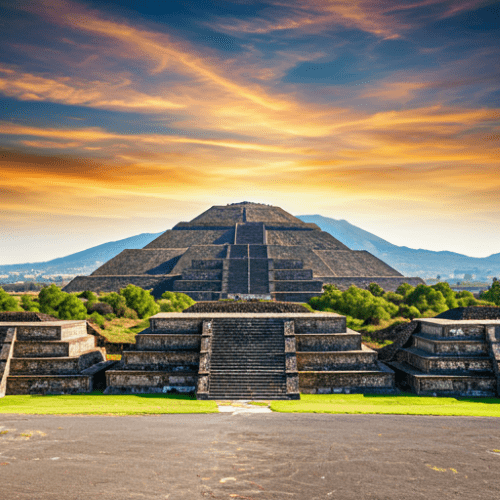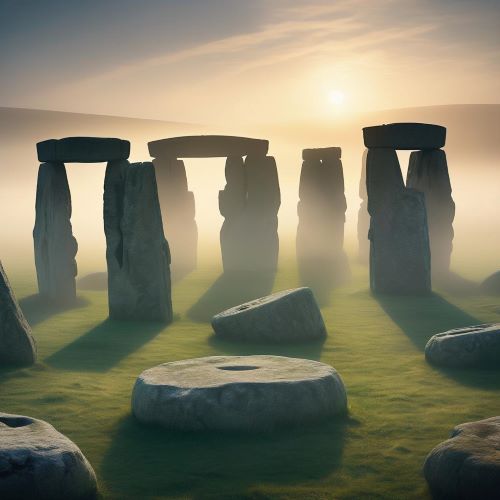Saqqara : The Forgotten Pyramid
At a glance
| Description | |
|---|---|
| Mythology | Egyptian Mythology |
| Country | Egypt |
| Closest airport | Cairo International Airport (CAI) |
| Type | Constructed |
| Accessibility | 08/10 |
Introduction
Saqqara is a mesmerizing testament to the ingenuity and spirituality of ancient Egypt. Located just south of modern-day Cairo, this vast necropolis served as the principal burial ground for the city of Memphis, one of Egypt’s earliest capitals. Though it often takes a backseat to the more famous Giza pyramids, Saqqara’s historical depth, architectural breakthroughs, and spiritual resonance make it a must-visit for anyone interested in Egypt’s ancient legacy. Most notably, it is the site of the Step Pyramid of Djoser—the world’s first large-scale stone structure—which revolutionized how Egyptians built monuments to eternity.
Beyond the Step Pyramid, Saqqara’s 7-square-kilometer landscape is dotted with tombs, temples, and ruins from multiple dynasties, offering a glimpse into over three millennia of uninterrupted ritual use. New discoveries here continue to reshape our understanding of ancient Egyptian beliefs, power structures, and burial practices.
Connection with Mythology
The spiritual fabric of Saqqara is tightly interwoven with ancient Egyptian mythology. The site is believed to be named after Sokar, an early funerary deity later syncretized with Osiris and Ptah—gods central to death, rebirth, and craftsmanship. Sokar was especially revered in Memphis, and his influence lingers throughout the necropolis in art, symbolism, and temple layouts.
A defining feature of Saqqara’s mythological role lies in its sacred animal burials. The Serapeum, a vast underground gallery, housed the mummified remains of Apis bulls—living representations of Ptah. Each burial was treated with royal ritual, emphasizing the connection between gods and earthly forms. Elsewhere, Saqqara also hosted burials of ibises linked to Thoth, falcons representing Horus, and even baboons. These practices illustrated how deeply animals were enmeshed in Egypt’s spiritual worldview.
Additionally, the Pyramid Texts carved into royal tombs at Saqqara—like those of Unas and Teti—serve as some of the earliest written religious scripts. These texts offered spells and guidance for pharaohs navigating the afterlife, cementing Saqqara as more than a burial site—it was a metaphysical map for immortality.
Ways to Get There
Reaching Saqqara from Cairo is relatively straightforward and offers several options depending on your preference for comfort and flexibility.
Private transport is the easiest and most direct way. Taxis or rideshare services like Uber can get you from central Cairo to the Saqqara plateau in under an hour. While getting there is simple, securing a return ride can be trickier due to the site’s remote setting—arranging round-trip transport is advisable.
For a more informative experience, guided tours are highly recommended. These often include nearby sites like Dahshur and Memphis, giving you a fuller understanding of the region’s historical context. Tours typically come with Egyptologist guides who explain the nuanced significance of each stop.
Adventurous travelers may opt for public transport, though it’s less convenient. You can take the metro to El-Ma’sara and then hire a local taxi. While this can save money, it’s not ideal for first-time visitors due to the multiple transfers and lack of clear signage.
What to Look For
Saqqara is a mosaic of ancient wonders, each revealing a different chapter of Egypt’s evolution.
The crown jewel is the Step Pyramid of Djoser, built during the 27th century BCE by Imhotep. This six-tiered pyramid not only marked the beginning of monumental architecture in Egypt but also established Imhotep as a revered figure, later deified as the god of medicine and wisdom.
Nearby, the Imhotep Museum displays tools, statues, and archaeological finds from across the site. It’s a compact yet informative stop that contextualizes Saqqara’s broader significance.
Equally impressive are the mastaba tombs of nobles and officials like Mereruka and Kagemni. These low, flat-roofed structures are adorned with vibrant reliefs depicting scenes from everyday life—agriculture, music, fishing, and banquets—providing vivid insights into ancient society.
Don’t miss the Serapeum, a network of underground chambers housing gigantic sarcophagi for the sacred Apis bulls. The engineering required to move these stone behemoths remains a marvel.
Smaller pyramids like those of Unas and Teti also hold intrigue. The Pyramid Texts within are both theologically significant and a linguistic milestone in ancient Egyptian script.
Need a place to stay? Book your hotel room now!
Importance in cultural history
Saqqara is more than a historical site—it’s a cultural palimpsest chronicling over 3,000 years of Egyptian civilization. As the primary cemetery for Memphis, Saqqara was pivotal in shaping burial customs that would influence the rest of Egypt and even parts of the Mediterranean world.
Its impact is particularly evident in architecture. The evolution from simple mud-brick mastabas to towering stone pyramids began here. The Step Pyramid set a precedent, paving the way for the later grandeur at Giza and beyond.
Religiously, Saqqara is where we see the earliest codification of spiritual doctrine. The Pyramid Texts mark a transition from oral to written religious traditions, influencing later works like the Coffin Texts and the Book of the Dead.
Ongoing excavations continue to unearth layers of history, from the Old Kingdom to the Greco-Roman period. Recent finds, including undisturbed sarcophagi and hidden tombs, keep Saqqara in the spotlight and highlight Egypt’s long-standing reverence for the dead.
Best time to travel
The desert climate around Saqqara means that timing your visit well can significantly impact your experience.
October to April is ideal, with pleasant temperatures and clearer skies. These months offer comfortable daytime weather for walking among the ruins, and the light is perfect for photography. February stands out as particularly favorable due to cooler weather and thinner crowds.
Spring (March–May) sees blooming desert flora and mild heat, making it a favorite for many travelers. Autumn (September–November) is equally pleasant, offering a good balance between weather and visitor numbers.
Avoid June through August, when temperatures can soar above 40°C. If visiting in summer, aim to arrive early in the morning and bring plenty of water, sun protection, and breathable clothing.
The site generally opens at 8:00 AM and closes by 5:00 PM, so arriving early also gives you a quieter, more serene experience before tour groups arrive.
Source
Egypt Tours Portal. (n.d.). Saqqara Pyramid Complex, Egypt | Facts & History. Retrieved from https://www.egypttoursportal.com/saqqara-pyramid-complex/
Egipto, T. (n.d.). Egyptian Mythology – Tour Egypt. Tour Egypt. Retrieved from https://www.touregypt.net/mythology/
Rome2Rio. (n.d.). How to get to Saqqara from Cairo by train, taxi or car. Retrieved from https://www.rome2rio.com/s/Cairo/Saqqara
Tripadvisor. (n.d.). Saqqara Necropolis (Saqqara) – All You Need to Know BEFORE You Go. Retrieved from https://www.tripadvisor.com/Attraction_Review-g294201-d306631-Reviews-Saqqara_Necropolis-Saqqara_Giza_Governorate.html
Discover Egypt’s Monuments. (2021, June 1). Saqqara – Discover Egypt’s Monuments. Retrieved from https://egymonuments.gov.eg/en/archaeological-sites/saqqara
Responsible Travel. (n.d.). Egypt in February – Responsible Travel. Retrieved from https://www.responsibletravel.com/holidays/egypt/best-time-to-visit/february
Time and Date. (n.d.). Weather in Saqqara, Egypt. Retrieved from https://www.timeanddate.com/weather/egypt/saqqara
Wikipedia. (2024, May 17). Saqqara – Wikipedia. Retrieved from https://en.wikipedia.org/wiki/Saqqara
Frequently Asked Questions
Lorem ipsum dolor sit amet, consectetur adipiscing?
Lorem ipsum dolor sit amet, consectetur adipiscing elit. Praesent convallis vestibulum justo, ac tincidunt nunc vehicula quis. Nullam id dolor quis orci malesuada feugiat. Curabitur aliquet libero at urna ullamcorper, ac ultricies nulla dapibus.
Lorem ipsum dolor sit amet, consectetur adipiscing?
Lorem ipsum dolor sit amet, consectetur adipiscing elit. Praesent convallis vestibulum justo, ac tincidunt nunc vehicula quis. Nullam id dolor quis orci malesuada feugiat. Curabitur aliquet libero at urna ullamcorper, ac ultricies nulla dapibus.
Lorem ipsum dolor sit amet, consectetur adipiscing?
Lorem ipsum dolor sit amet, consectetur adipiscing elit. Praesent convallis vestibulum justo, ac tincidunt nunc vehicula quis. Nullam id dolor quis orci malesuada feugiat. Curabitur aliquet libero at urna ullamcorper, ac ultricies nulla dapibus.
Lorem ipsum dolor sit amet, consectetur adipiscing?
Lorem ipsum dolor sit amet, consectetur adipiscing elit. Praesent convallis vestibulum justo, ac tincidunt nunc vehicula quis. Nullam id dolor quis orci malesuada feugiat. Curabitur aliquet libero at urna ullamcorper, ac ultricies nulla dapibus.
Lorem ipsum dolor sit amet, consectetur adipiscing?
Lorem ipsum dolor sit amet, consectetur adipiscing elit. Praesent convallis vestibulum justo, ac tincidunt nunc vehicula quis. Nullam id dolor quis orci malesuada feugiat. Curabitur aliquet libero at urna ullamcorper, ac ultricies nulla dapibus.








